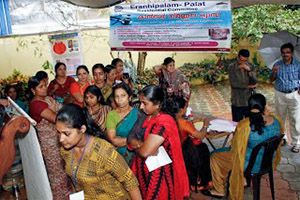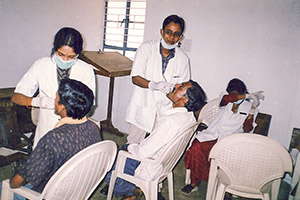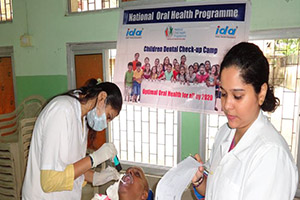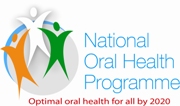Oral Cancer Foundation
Oral Cancer Foundation (OCF) is a professionally led “call to action” programme to eradicate oral cancer, strive for a ‘cancer free-India’ and thus improve the oral health of Indian by 2020.

The OCF aims to establish a broad alliance of key influencers and policy makers from research, education, clinical practice, public health, government and industry, partnering in a common goal to effect fundamental change in health systems and individual behaviour to achieve the 2020 goal of optimal oral health for all.

Oral Cancer Foundation (OCF) is a professionally- led “call to action” programme to eradicate oral cancer, strive for a ‘cancer free-India’ and thus improve the oral health of Indian by 2020.
Search SPOT Center
For Public


Public Forum
A sore or ulcer in the mouth that persists more than three weeks. A white or red patch on the gums, tongue, or lining of the mouth. A lump anywhere in the mouth.
For Professional


Professional Forum
A sore or ulcer in the mouth that persists more than three weeks. A white or red patch on the gums, tongue, or lining of the mouth. A lump anywhere in the mouth.
Media Center
Did you Know?
2,500 persons die every day due to tobacco- related diseases in India.
Smoking accounts for 1 in 5 deaths among men and 1 in 20 deaths among women, accounting for an estimated 9,30,000 deaths in 2010.
Estimated number of people living with the disease: around 2.5 million
Every year, new cancer patients registered: Over 7 lakh Cancer-related deaths: 5,56,400
Deaths in the age group between 30-69 years
Total: 3, 95,400 (71% of all cancer related deaths)
- Men: 2,00,100
- Women: 1,95,300
Cancers of oral cavity and lungs in males account for over 50% of all cancer deaths in India.
The top five cancers in men and women account for 47.2% of all cancers; these cancers can be prevented, screened for and/or detected early and treated at an early stage. This could significantly reduce the death rate from these cancers.
| # | Men | Women |
|---|---|---|
| 1 | Lip, oral Cavity | Breast |
| 2 | Lung | Cervix |
| 3 | Stomach | Colorectum |
| 4 | Colorectum | Ovary |
| 5 | Pharynx | Lip, Oral Cavity |
Oral Cancer
Oral cancer is the most common cancer in India amongst men (11.28% of all cancers), fifth most frequently occurring cancer amongst women (4.3% of all cancers) and the third most frequently occurring cancer in India amongst both men and women.
Globocan 2012 data:
- New cases registered: 77,003
- Deaths: 52,067
Around 80% of oral cancers are directly attributable to tobacco use.
The mean age of oral cancer is 50 years.
The rates for oral cancer among males are significantly higher than females and these rates increase with age.
Survival rate (5-year)
- Patients with early stage oral cancer: 82%
- Patients with advanced stages: 27%
Did you know that oral cancer is abnormal (malignant) growth of body cells in any part of the oral cavity; oral cancer is sometimes termed head and neck cancer.
Did you know that early detection for oral cancer results in a survival outcome of 90%…However, delayed diagnosis means survival rates plummet to as little as 50%.
Did you know that risk factors for oral cancer are many like tobacco use alcohol use, sun exposure (lips), anyone who has already had some form of head and neck cancer, and human papilloma virus infection.
Did you know that one person in ten is unaware of the threat of mouth cancer.
Did you know that more than one in four are unaware smoking is leading cause of mouth cancer.
Did you know that symptoms of oral cancer may include red, white and/or a mixture of these colors in patches, a non-healing sore in the mouth or on the lips, bleeding, loose teeth, swallowing problems, new denture problems, lumps or bumps on the neck, and earaches.
Did you know that oral cancer is diagnosed by the patient's history and physical exam and definitively by a biopsy of oral tissue; occasionally, CT scans, MRI scans or PET scans may be used.
Did you know that the treatment of oral cancer is usually decided in conjunction with the patient's doctor.
Did you know that methods of treatment for oral cancer include surgery, radiation therapy, and/or chemotherapy.
Did you know that the side effects of oral cancer treatment may include pain, weakness, altered facial appearance, difficulty in swallowing or chewing food, dry mouth, tooth decay, sore throat, sore gums, bleeding, infections, denture problems, voice quality, thyroid problems, fatigue, hair loss, nausea, vomiting, and diarrhea.
Did you know that rehabilitation after oral cancer surgery consists of regaining strength, developing a healthy diet the patient can tolerate, and possibly dental implants or facial reconstruction surgery.
Did you know that after treatment and rehabilitation, checkups are needed to maintain health and make sure that the oral cancer does not recur.
Did you know that Oral cancer treatment can result in significant lifestyle changes; most patients are advised to discuss lifestyle problems with dental professionals to help patients get the care they may need.
Did you know that smokeless "spit" tobacco contains over 2,000 chemicals, many of which have been directly related to causing cancer.
Did you know that chewing tobacco increases the risk of oral cancer and the excess risk of cancers of the cheek and gum may reach nearly fifty-fold among long-term snuff users.
Did you know that smokeless tobacco use is responsible the development of a portion of oral leukoplakias in teenage and adult users. The degree to which the use of tobacco affects the oral had and soft tissues is depending on the site of action, type of smokeless product used, frequency and duration of use.
Did you know that longer use of smokeless tobacco results in a prevalence of leukoplakic lesions. Oral leukoplakias commonly found at the site of tobacco placement.
Did you know that a portion of these dysplastic lesions can further develop into carcinomas of either a verrcous or squamous cell variety.
Preventing Oral Cancer
Here’s how you can take an active role in preventing oral cancer or detecting it in its early stages:
- Always brush and floss your teeth regularly. An unhealthy mouth reduces your immune system and inhibits your body’s ability to fight off potential cancers.
- Do not smoke (or chew) any type of tobacco product. If you are a smoker, even with a casual habit, make the decision to stop
- Drink alcohol in moderation (one to two drinks per day) and never binge drink. The risk of developing oral cancer increases with the amount and length of time alcohol and tobacco products are used.
- Limit your exposure to the sun. We all know we need to use sunscreen, but do we remember to apply it to our lips? Always use UV-A/B-blocking sun protection on your lips when you are in the sun. Repeated exposure increases the risk of cancer on the lips, especially the lower lip. There are a lot of handy lipstick-size sunscreen tubes to pop in your purse for everyday use. Some even come with a colour tint and flavour to replace your regular lip gloss or moisturizer.
- Exercise regularly. An active lifestyle is known to boost the immune system and help ward off cancer.
- Choose cancer-fighting foods in your diet. Eat lots of beans, berries, cruciferous vegetables (like cabbage and broccoli), dark green leafy vegetables, flaxseed, garlic, grapes, green tea, soy and tomatoes for their role in cancer prevention.
- How you prepare those foods is also important in the prevention of cancer. Replace frying and grilling with baking, boiling or steaming. Use healthy spices like garlic, ginger and curry powder for added flavour.
- See your dentist regularly (at least every six months) and ask for an oral cancer screening to be done.
- Conduct a self exam at least once a month. It only takes a few minutes of your time, but could make a big difference in your life. Buy a handy mouth mirror for those hard-to-see areas. Be sure to check the back and sides of your tongue. If you see or feel anything suspicious ‘ lumps, bumps, tender areas, white, red or grey patches, see your dentist to have it checked.
If you are using tobacco in any form a dental visit is a must. The dentist will be able to:
- Perform a competent oral cancer examination; to implement an office protocol for oral cancer screening especially the high risk patients.
- Describe oral lesions of local and systemic etiology;
- Identify oral lesions that should raise the suspicion of malignancy;
- Appropriately select and consider using diagnostic adjuncts to assist in oral cancer early detection;
- Manage questionable and suspicious oral lesions;
Learn what's at stake : Dentists should be able to articulate the differences between the survival and quality of life for the typical stage III or IV patient and for an individual whose oral cancer is detected in its earliest stages.
- Significance of lesion size
- Significance of lesion thickness
- Significance of regional spread and metastases
Learn risk factors: Your dentist should be able to list the major risk factors for oral squamous cell carcinoma (SCCA).
- Burnt tobacco products (cigarettes, cigars and pipe smoking).
- Heavy alcohol consumption.
- HPV for a subset of oral cancers.
- Possible associations with immunosupression, family history, diet and other suspected factors.
Get to know the high risk sites: Dentists will be able to describe the high risk sites for oral SCCA.
- Highest risk : Floor of mouth, soft palate complex and lateral tongue.
- Less concern: Gingiva and buccal mucosa (inside of cheeks and lips)
- Least concern: Dorsum of tongue and hard palate
Walk in at your dental clinic to learn what about the earliest appearance: Dentists will be able to identify suspicious lesions.
- Abandon the dogmatic and counterproductive overemphasis on leukoplakia.
- Focus on the challenges of finding subtle red lesions on a red/pink background as well as lesions with more obvious white components .
- Any persistent alteration of normal mucosa is suspect if unresolved >2 weeks./
Get the diagnosis: Dentists will be able to discuss diagnostic techniques.
- Benefits and concerns related to brush biopsy.
- The indications and limitations of other adjuncts.
- Toluidine blue and how it may be utilized.
- The need for an obsessive search for lesions in the high risk population.
Are are responsible for detection : Dentists are responsible for diagnosing early squamous cell carcinoma (SCCA).
- Most physicians are inadequately trained and have neither the time nor the interest in conducting a meticulous examination of the oral soft tissues .
- Dentists are better prepared for oral cancer screening at the same level as other dental procedures .
Visit the dentist to know your treatment options: Dentists will be able to describe this
- Early lesions are treated with surgery or radiation.
- When must the neck be treated?.
- When are radiation therapy and chemotherapy used?.
Learn about the complications: Dentists will be able to discuss complications of the disease and its treatment
- Surgery.
- Radiation and chemotherapy.
- Additional primary lesions in the upper aerodigestive tract.
Learn about behavior change: Dentists should be able to discuss methods for influencing the behavior of their patients.
- Smoking cessation.
- Avoiding excessive alcohol intake.
- Seeking routine examination.
Learn more about demographics and racial disparities: Dentists should be able to describe the subpopulations at elevated risk and the huge disparities between the races regarding oral cancer.
- Incidence
- Stage at Diagnosis
- Mortality
Oral Health Magazine
Dental professionals to volunteer to take care of those who are disabled or elderly or medically fragile and cannot afford the needed dental care.

Testimonial

Self Examination

Get informed. Know the early signs of oral cancer. Early stage oral cancer is often asymptomatic – you may not FEEL it.
Watch out for:
- Persistent mouth sore
- Pain in mouth or ear
- Chronic hoarseness
- Non-tender lump in neck
- Abnormal swallowing
- Peculiar sore throat
Step's
- Tongue ‘n GauzeExtend your tongue as far as it can go, examining the sides and underside for white and red patches, and feels your tongue for lumps. NOTE: This is the most common site of oral cancers in non- smokers.
- Lip & Cheek Roll Feel for lumps or bumps, looking for white or red areas that should not be there.
- Double-Digit Probe Examine the floor of your mouth from the top and bottom simultaneously for lumps, looking for white and red patches.
- Palate Tickle Check the roof of your mouth for lumps and areas of softness on the hard palate, looking for white and red patches.
- Neck Caress Palpate your neck for enlarged lymph nodes a possible sign of infection or something more serious.
- Tonsil Depress your tongue with a dental mirror, examining your tonsils for symmetry, enlargement, redness, or unusual bumps.
Examine extra carefully the tongue and floor of mouth. These two sites account for roughly 60% of all oral cancers.
Bright light (flashlight)
Washcloth or gauze (To pull out tongue)
- Color difference
- Texture change
- Lesions
- Lumps
Take a pic and make an appointment with your dentist.
IDA Recommendation
Activate dental professionals in oral health
Professionals in oral health and other health disciplines to become more actively involved in cancer detection for timely diagnosis and referral. Realize the importance of preventing tobacco and heavy alcohol use, by
About IDA







[0]}})






